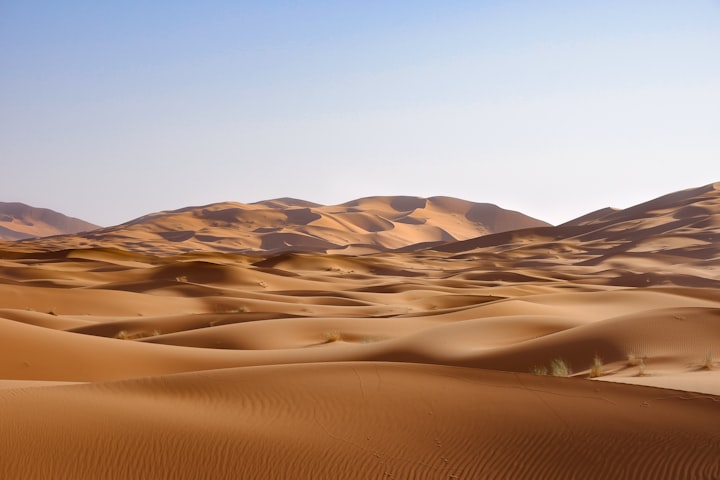Secrets of the Sahara
A Journey through Time, Culture, and the Enigmatic Circles of the Sahara

Embark on a journey through the vast expanse of Africa, where the enchanting landscape of the Sahara Desert awaits, adorned with its unique array of wildlife and a tapestry of diverse cultures and languages. As the blazing sun paints the sky, your quest for water and respite becomes a gripping odyssey. Days of relentless trekking have led you toward the allure of the coveted Oasis. Yet, the horizon appears to stretch endlessly, playing tricks on your fatigued mind. Your body, succumbing to the relentless heat, mirrors the sensation of consuming fiery peppers and then some, evidenced by your profuse perspiration. The temperature soars to a scorching 100 degrees Fahrenheit on average, a testament to your presence in the world's most expansive hot desert. Mind you, it's called a "hot desert" because the grandest desolate landscapes can be found in the frozen realms of Antarctica and the Arctic. The Sahara Desert sprawls across Northern Africa, spanning from the Atlantic to the Red Sea. Its dimensions are so staggering that it could accommodate about a hundred thousand Disney World theme parks placed side by side. Scientists note that its boundaries continue to expand, spurred by the phenomenon known as desertification, a process that turns fertile land into arid desert.
While discussing deserts, it's important to clarify that for a region to be officially deemed a desert, it must receive less than four inches of rainfall annually. Consequently, these arid landscapes are marked by minimal humidity, soaring daytime temperatures reaching a blistering 130 degrees Fahrenheit, and a scarcity of both flora and fauna due to the lack of water. However, this description does not encapsulate the entirety of the Sahara's history. Roughly twenty thousand years ago, the Sahara was far from the barren expanse it is today. Recent discoveries have unveiled traces of a lush and thriving Sahara, aptly referred to as the "green Sahara." The Sahara, in those ancient times, was a vibrant oasis teeming with diverse life forms. Unearthed rock paintings left behind by nomadic artists provide a vivid glimpse into this bygone era. The paintings diverge remarkably from the current desert landscape, depicting lush jungles, towering giraffes, hippos, and even livestock such as cattle and sheep. These depictions astounded explorers and raised questions about the environment's transformation.
Geologists delved into the mystery, ultimately shedding light on the Sahara's verdant past. Evidence from sediment samples retrieved from deep-sea areas off Mauritania's coast confirmed the presence of a greener Sahara. This data correlated the amount of Saharan dust blowing into the ocean with the climate's dryness; the more dust detected, the drier the climate. Earth's axial tilt, which fluctuates over time, plays a significant role in these climatic shifts. Around twenty thousand years ago, Earth's tilt increased, resulting in heightened solar radiation and subsequently influencing humidity levels and monsoon activity. The West African Monsoon was particularly impacted, leading to increased moisture and an expanding Sahara. As vegetation thrived, holding onto moisture more effectively than barren sand, natural basins and expansive lakes dotted the Sahara.
Archaeological findings unveiled a bustling society that flourished amidst these verdant conditions approximately nine thousand years ago. Fireplaces, hunting tools, and remnants of fish bones evidenced a vibrant culture harnessing the region's abundant resources. Earth's orbital cycles dictate solar radiation, rendering the return of a green Sahara inevitable. However, the Sahara's recent expansion, documented by the National Science Foundation's studies, is a stark reminder of the challenges modern societies face. Desertification encroaches on fertile lands, transforming them into arid deserts. Rapid population growth in the Sahel region, fueled by settled farmers, intensifies land usage and soil degradation.
The Sahara, once an ocean of green, now faces the risk of its precious resources slipping away as climate change and human activities converge. The mystery of the Sahara circles unraveled through a quest marked by Google Earth, ancient wells, sardine cans, and buried dynamite. These circles, initially thought to be traces of ancient irrigation or seismic surveys, revealed their true nature as remnants of oil exploration in the mid-20th century. Workers had dug holes filled with dynamite to search for oil, leaving behind a puzzle that puzzled curious minds for years. As you stand amidst the Sahara's majestic dunes, the history of the land whispers its tales of transformation, survival, and the intertwining threads of nature and human exploration.






Comments
There are no comments for this story
Be the first to respond and start the conversation.